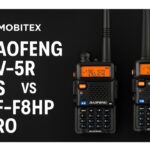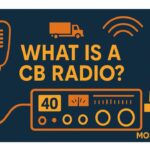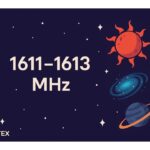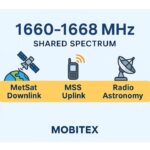Frequency
1457 MHz
Range
1452–1492 MHz
Band Group
L‑Band Digital Broadcasting (1452–1492 MHz) — DAB Core
🌐 Summary
The 1457 MHz allocation is part of the L‑Band Digital Broadcasting (1452–1492 MHz) — DAB Core spectrum. This range is used worldwide for critical applications that keep our communications and infrastructure running smoothly. On this page we highlight how each band is applied in real systems, from regulatory assignments to everyday devices. Our goal is to make spectrum data clear and practical for engineers, regulators, and enthusiasts alike.
Key uses of this band include: L‑band around 1457 MHz supports DAB/DAB+ in ITU Region 1 and LTE SDL or fixed wireless in select markets. It offers mid‑band coverage with moderate penetration and requires careful coexistence with telemetry below 1452 MHz and MSS above 1492 MHz..
Used globally for digital audio broadcasting; adjacent to telemetry band below 1452 MHz; under evaluation for supplemental downlink and 5G NTN use.
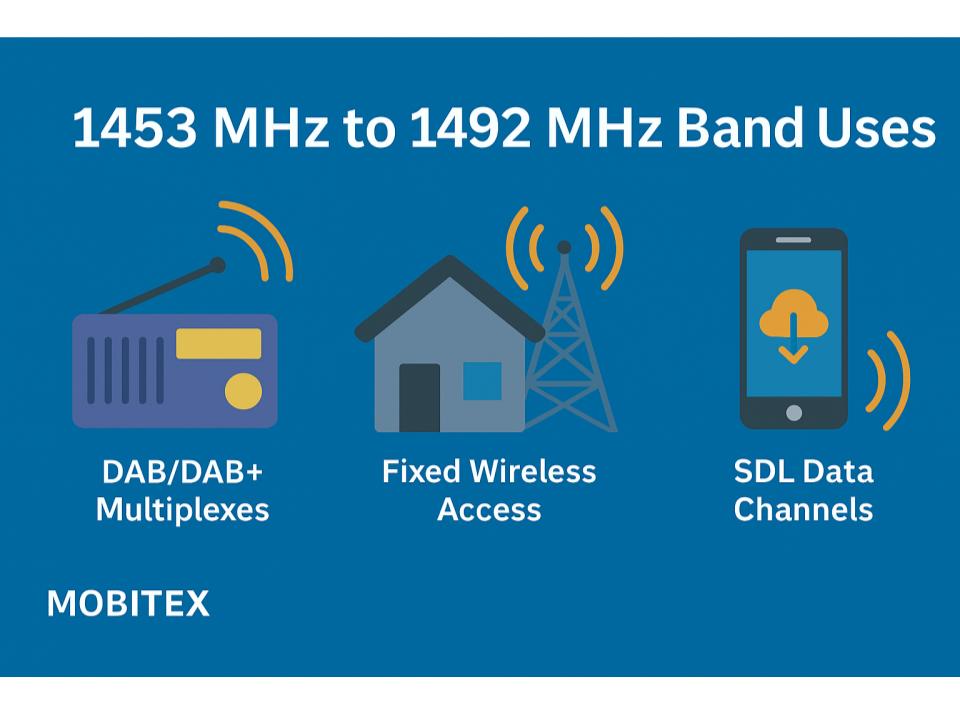
🔍 Explore the full RF Spectrum database
📡 Band & Geometry key
| Field | Value |
|---|---|
| Wavelength (m) | 0.20576 |
| Waveforms | COFDM (DAB), QPSK/OFDM (broadband) |
| Antenna Form Factor (Typical) | Whip/patch (~5 cm ¼-wave) |
| Band Family | Broadcasting / Mobile L‑Band |
| Band | 1452–1492 MHz L‑Band Digital Audio Broadcasting (DAB) / Mobile SDL (region‑dependent) |
| Primary Common Name | L-band |
| FSPL @ 1 km [dB] | – |
| FSPL @ 10 km [dB] | – |
| Fresnel Radius @ 1 km (m) | 7.17 |
| Band Group | L‑Band Digital Broadcasting (1452–1492 MHz) — DAB Core |
| Tax Band Family | UHF/L-band Transition |
| Tax Band Class | 1453 MHz – 1492 MHz UHF/L-band Transition Broadcast / Mobile (SDL) |
🧩 Applications & Usage
| Field | Value |
|---|---|
| Primary Application | Digital Audio Broadcasting (DAB/DAB+) single‑frequency networks; emerging SDL coexistence in some regions |
| Lower Neighbor Use | SDL/telemetry, program making & special events (country-specific) |
| Upper Neighbor Use | SDL downlink; proximity to MSS requires tight OOBE control |
| Typical Services Devices | DAB transmitters/receivers; LTE SDL small cells; FWA CPE/backhaul |
| Market Common Devices | DAB receivers, vehicular tuners, base stations |
| Refarming Use | Possible re-use for LTE / 5G supplemental downlink |
| Device Ecosystem Size | – |
| Device Hotspots (MHz) | – |
| Device Category | Broadcast receivers; vehicular tuners; base transmitters |
| Typical Use Cases | Digital Audio Broadcasting (DAB/DAB+); trial fixed wireless |
| Modulation (Device) | – |
| Channel Width (Device) [kHz] | – |
| Device Region Profiles | – |
| Per-Region EIRP Or Duty (Device) | – |
| Allocation Relevance (Device) | – |
| Adjacent-Band Collision Risks (Device) | – |
| Example Devices Or Skus | – |
| Common Protocols | DAB, DAB+, T-DMB, experimental LTE-L-Band |
🗒️ Notes
| Field | Value |
|---|---|
| Receiver Selectivity Notes | Broadcast-grade filters; vehicular tuners with SAW/ceramic IF |
| Interference Notes | Coordinate with neighboring allocations; manage OOBE and PIM |
| Compatibility Risk Notes | Protect telemetry below 1452 and MSS above 1492; avoid intermod with nearby L/S‑band services |
| Notes | Used globally for digital audio broadcasting; adjacent to telemetry band below 1452 MHz; under evaluation for supplemental downlink and 5G NTN use. |
| Propagation Notes | Excellent for line-of-sight broadcast and urban coverage |
⚙️ Technical Rules
| Field | Value |
|---|---|
| Lower Band Frequency Limit | 1452 |
| Upper Band Frequency Limit | 1492 |
| EIRP Indoor Limits | N/A (broadcast band) |
| EIRP Outdoor Limits | License-specific; typical base EIRP 43–65 dBm |
| PSD Limit | License-specific; observe national DAB mask |
| Emission Mask Class | Broadcast COFDM mask |
| Guardband Minimum [kHz] | 1000 |
| Typical Bandwidths | 1.5–5 MHz |
| Autocalculated Bandlimits | – |
| Typical Bandwidths (Estimated) | 1.5–5 MHz |
| Max EIRP [dBm] | – |
| Power Source Or Duty Profile (Typical) | Continuous broadcast (100% duty) |
| Channelization Plan | DAB block plan (A–L = 1452.960–1491.936 MHz) |
| Channelization | DAB blocks ≈1.536 MHz; LTE SDL channels 5/10/15/20 MHz |
| Guard Band Requirement | – |
| OOB Emission Limit [dBm/MHz] | ≤ –25 dBm/MHz (typical broadcast mask) |
| Spurious Emission Limit (dBm) | ≤ –36 dBm (typical) |
| RX Blocking Min [dBm] | N/A (receive-only consumer devices) |
| Duplexing | Downlink (Broadcast) / Simplex |
| Duplexing Information | – |
| Uplink Pairing | None (SDL/DAB are downlink or broadcast only) |
| Downlink Pairing | Downlink-only (SDL); Broadcast (DAB) |
| Paired Band Info | – |
| Max EIRP [dBm] | – |
| Channelization Block Size | – |
| 3GPP Band Number | |
| Example 3GPP Bands | LTE/NR Band 32 (1452–1496) — Downlink/SDL only |
| LTE Uplink Bands | None (SDL DL‑only) |
| LTE Downlink Bands | B32 (SDL) where licensed |
| NR Uplink Bands | None (SDL DL‑only) |
| NR Downlink Bands | n32 (SDL) where licensed |
| Guard Bands | Maintain ≥0.5–1 MHz guard between dissimilar systems (DAB vs SDL/fixed); strict mask compliance for multiplex edges. |
| Protocol Or Standard | – |
🌎 Country Overrides
| Field | Value |
|---|---|
| Tax Service Category | Broadcasting / Mobile / Fixed |
| Tax License Type | Licensed broadcast / fixed |
| Tax Regions | Global (allocations vary by administration) |
| ITU Region 1 (Europe, Africa, Middle East (west of Persian Gulf), Western Russia & Mongolia) | Region 1: DAB/DAB+ widely allocated in 1452–1492 MHz; SDL recognized in certain CEPT decisions; national plans vary. |
| ITU Region 2 (North America, South America, Central America, Caribbean, Greenland, Eastern Pacific Islands (Americas region)) | Region 2: Limited DAB in L‑band; allocations may favor Fixed/Mobile uses and trials of SDL; deployment varies by country. |
| ITU Region 3 (Asia, Australia, Pacific Islands, Oceania, Indian Subcontinent, East Asia & Southeast Asia) | Region 3: Mixed adoption; some administrations allocate to Fixed/Mobile links or DAB trials; SDL considered in select markets. |
| License Type | Licensed / Commercial (broadcast or mobile) |
| Primary Application | Digital Audio Broadcasting (DAB/DAB+) single‑frequency networks; emerging SDL coexistence in some regions |
| Primary Services | Broadcasting (DAB/DAB+) primary in Region 1; Fixed/Mobile in others |
| Spurious Emission [dBm] | ≤ –36 dBm (typical) |
| Lower Neighbor Use | SDL/telemetry, program making & special events (country-specific) |
| Upper Neighbor Use | SDL downlink; proximity to MSS requires tight OOBE control |
| Licensing Model | National licensing for multiplexes or mobile SDL; refarming policies vary |
| Typical Services Devices | DAB transmitters/receivers; LTE SDL small cells; FWA CPE/backhaul |
| US FCC Alloc | No nationwide DAB in US; portions used/licensable for FWA/experimental– |
| CA IC Alloc | No L‑band DAB in CA; limited/local FWA or trials by authorization– |
| UK Ofcom Alloc | DAB blocks 11A–12D (1452–1492 MHz)– |
| US Ref | See FCC Part 27/90 allocations and market licenses (admin dependent) |
| Typical Bandwidths | 1.5–5 MHz |
| Market Licensing Model | Commercial broadcast multiplexes or mobile operator SDL spectrum |
| Market Common Devices | DAB receivers, vehicular tuners, base stations |
| Fresnel Radius (1st, 1 km) [m] | 7.17 |
| Typical Bandwidths (Estimated) | 1.5–5 MHz |
| Auction Status | Assigned / Under study |
| Refarming Use | Possible re-use for LTE / 5G supplemental downlink |
| Typical Site Spacing km | 5–20 / 20–60 |
| Device Ecosystem Size | – |
| Traffic Load Share | Dominated by broadcast (~90%) |
| Device Hotspots (MHz) | – |
| Device Category | Broadcast receivers; vehicular tuners; base transmitters |
| Typical Use Cases | Digital Audio Broadcasting (DAB/DAB+); trial fixed wireless |
| Typical Center Frequencies [MHz] | – |
| Rule Part (Fcc Or Region) | – |
| Modulation (Device) | – |
| Channel Width (Device) [kHz] | – |
| Device Region Profiles | – |
| Per-Region EIRP Or Duty (Device) | – |
| Allocation Relevance (Device) | – |
| Adjacent-Band Collision Risks (Device) | – |
| Example Devices Or Skus | – |
| Antenna Form Factor (Typical) | Whip/patch (~5 cm ¼-wave) |
| Power Source Or Duty Profile (Typical) | Continuous broadcast (100% duty) |
🛡️ Regulatory & Neighbors
| Field | Value |
|---|---|
| Lower Band Frequency Limit | 1452 |
| Upper Band Frequency Limit | 1492 |
| Rx Blocking Min dBm | N/A (receive-only consumer devices) |
| Lower Neighbor Use | SDL/telemetry, program making & special events (country-specific) |
| Upper Neighbor Use | SDL downlink; proximity to MSS requires tight OOBE control |
| Lower Neighbor Band | 1427–1452 MHz – Fixed / Mobile / Telemetry / MBANS |
| Lower Neighbor Range | 1428–1452 MHz |
| Upper Neighbor Label | Upper L‑band SDL / MSS edge |
| Upper Neighbor Range | 1492–1518 MHz (SDL), 1525–1559 MHz (MSS DL) |
| Adjacent-Band Collision Risks (Device) | – |
| Real-World Range (Indoor/Outdoor) | 20–100 km line-of-sight; terrain dependent |
| US FCC Alloc | No nationwide DAB in US; portions used/licensable for FWA/experimentalNo nationwide DAB in US; portions used/licensable for FWA/experimental |
| CA IC Alloc | No L‑band DAB in CA; limited/local FWA or trials by authorizationNo L‑band DAB in CA; limited/local FWA or trials by authorization |
| UK Ofcom Alloc | DAB blocks 11A–12D (1452–1492 MHz)DAB blocks 11A–12D (1452–1492 MHz) |
| Regulatory References | US: See FCC Part 27/90 allocations and market licenses (admin dependent); CA: See ISED Canadian Table of Frequency Allocations (admin dependent); UK: – |
| Global Harmonization | – |
| Crossborder Coordination | – |
| Sharing Mechanism | Use SFN timing for DAB; apply frequency coordination and synchronized frames for SDL; geographic separation for high‑EIRP fixed links. |
| Auction Status | Assigned / Under study |
| Guard Or Pair | Guard bands vary by admin; adhere to 3GPP/ETSI masks |
📈 Market & Measurements
| Field | Value |
|---|---|
| Noise Floor | Thermal ≈ −174 dBm/Hz; environment dependent |
| Interference Cases | Adjacent SDL/telemetry and MSS below/above; need sharp filters |
| Lower Neighbor Range | 1428–1452 MHz |
| Upper Neighbor Range | 1492–1518 MHz (SDL), 1525–1559 MHz (MSS DL) |
| Interference Notes | Coordinate with neighboring allocations; manage OOBE and PIM |
| Market Licensing Model | Commercial broadcast multiplexes or mobile operator SDL spectrum |
| Market Commercial Value | High in Europe (DAB), moderate elsewhere |
| Market Common Devices | DAB receivers, vehicular tuners, base stations |
| Market Deployment Density | Dense in Europe, sparse elsewhere |
| Noise Floor (Estimated) | Thermal ≈ −174 dBm/Hz; environment dependent |
| Market Commercial Value (Estimated) | High in Europe (DAB), moderate elsewhere |
| Ecosystem Maturity | Established (Europe), emerging elsewhere |
| Indoor Penetration | – |
| Known Interference | Potential interference among DAB multiplexes without careful SFN planning; manage OOBE into adjacent SDL or fixed/mobile links. |
| Device Ecosystem Size | – |
| Real-World Range (Indoor/Outdoor) | 20–100 km line-of-sight; terrain dependent |
| Antenna Form Factor (Typical) | Whip/patch (~5 cm ¼-wave) |
| Ecosystem Maturity | Established (Europe), emerging elsewhere |
| Device Ecosystem Size | – |
| Chipset Availability | DAB demodulators, Qualcomm L-Band test chipsets |
| Operator Deployments | BBC, NRK, TDF, local broadcasters |
| Technology Generations Deployed | DAB / DAB+, proprietary FWA |
| Roaming Support | – |
| Traffic Load Share | Dominated by broadcast (~90%) |
| Indoor Penetration | – |
| Known Interference | Potential interference among DAB multiplexes without careful SFN planning; manage OOBE into adjacent SDL or fixed/mobile links. |
| Occupancy | Region 1: Medium–High (DAB); Regions 2/3: Low–Medium, localized |
| Occupancy Bucket Pct | – |
| Latency Profile | – |
| Common Channels Or Profiles | DAB blocks 11A–12D; 1.5 MHz block spacing |
| Security Features | – |
| Lbt Or Fhss Requirement | – |
| Popularity (Installed Base) | – |
| Coexistence Tips | Band-pass filtering at 1452 / 1492 MHz edges |
| Latency Class | Best-effort (broadcast) |
| Device Hotspots (Scoped && Tagged) | 11A–12D blocks (1452.960–1491.936 MHz) |
